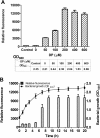Development of a Fur-dependent and tightly regulated expression system in Escherichia coli for toxic protein synthesis
- PMID: 23510048
- PMCID: PMC3621691
- DOI: 10.1186/1472-6750-13-25
Development of a Fur-dependent and tightly regulated expression system in Escherichia coli for toxic protein synthesis
Abstract
Background: There is a continuous demanding for tightly regulated prokaryotic expression systems, which allow functional synthesis of toxic proteins in Escherichia coli for bioscience or biotechnology application. However, most of the current promoter options either are tightly repressed only with low protein production levels, or produce substantial protein but lacking of the necessary repression to avoid mutations initiated by leaky expression in the absence of inducer. The aim of this study was to develop a tightly regulated, relatively high-efficient expression vector in E. coli based on the principle of iron uptake system.
Results: By using GFP as reporter, PfhuA with the highest relative fluorescence units, but leaky expression, was screened from 23 iron-regulated promoter candidates. PfhuA was repressed by ferric uptake regulator (Fur)-Fe2+ complex binding to Fur box locating at the promoter sequence. Otherwise, PfhuA was activated without Fur-Fe2+ binding in the absence of iron. In order to improve the tightness of PfhuA regulation for toxic gene expression, Fur box in promoter sequence and fur expression were refined through five different approaches. Eventually, through substituting E. coli consensus Fur box for original one of PfhuA, the induction ratio of modified PfhuA (named PfhuA1) was improved from 3 to 101. Under the control of PfhuA1, strong toxic gene E was successfully expressed in high, middle, low copy-number vectors, and other two toxic proteins, Gef and MazF were functionally synthesized without E. coli death before induction.
Conclusions: The features of easy control, tight regulation and relatively high efficiency were combined in the newly engineered PfhuA1. Under this promoter, the toxic genes E, gef and mazF were functionally expressed in E. coli induced by iron chelator in a tightly controllable way. This study provides a tightly regulated expression system that might enable the stable cloning, and functional synthesis of toxic proteins for their function study, bacterial programmed cell death in biological containment system and bacterial vector vaccine development.
Figures





Similar articles
-
A novel set of vectors for Fur-controlled protein expression under iron deprivation in Escherichia coli.BMC Biotechnol. 2016 Sep 13;16(1):68. doi: 10.1186/s12896-016-0298-1. BMC Biotechnol. 2016. PMID: 27619907 Free PMC article.
-
Iron chelator-inducible expression system for Escherichia coli.J Microbiol Biotechnol. 2008 Aug;18(8):1357-63. J Microbiol Biotechnol. 2008. PMID: 18756094
-
Fur positive regulation of iron superoxide dismutase in Escherichia coli: functional analysis of the sodB promoter.J Bacteriol. 2000 Jul;182(13):3802-8. doi: 10.1128/JB.182.13.3802-3808.2000. J Bacteriol. 2000. PMID: 10850997 Free PMC article.
-
Members of the Fur protein family regulate iron and zinc transport in E. coli and characteristics of the Fur-regulated fhuF protein.J Mol Microbiol Biotechnol. 2002 May;4(3):217-22. J Mol Microbiol Biotechnol. 2002. PMID: 11931550 Review.
-
The discovery of mRNA interferases: implication in bacterial physiology and application to biotechnology.J Cell Physiol. 2006 Dec;209(3):670-6. doi: 10.1002/jcp.20801. J Cell Physiol. 2006. PMID: 17001682 Review.
Cited by
-
Strategies for Successful Over-Expression of Human Membrane Transport Systems Using Bacterial Hosts: Future Perspectives.Int J Mol Sci. 2022 Mar 30;23(7):3823. doi: 10.3390/ijms23073823. Int J Mol Sci. 2022. PMID: 35409183 Free PMC article. Review.
-
Flagellar region 3b supports strong expression of integrated DNA and the highest chromosomal integration efficiency of the Escherichia coli flagellar regions.Microb Biotechnol. 2015 Jul;8(4):726-38. doi: 10.1111/1751-7915.12296. Microb Biotechnol. 2015. PMID: 26074421 Free PMC article.
-
Enhancing yields of low and single copy number plasmid DNAs from Escherichia coli cells.J Microbiol Methods. 2017 Feb;133:46-51. doi: 10.1016/j.mimet.2016.12.016. Epub 2016 Dec 23. J Microbiol Methods. 2017. PMID: 28024984 Free PMC article.
-
One cannot rule them all: Are bacterial toxins-antitoxins druggable?FEMS Microbiol Rev. 2015 Jul;39(4):522-40. doi: 10.1093/femsre/fuv002. Epub 2015 Mar 21. FEMS Microbiol Rev. 2015. PMID: 25796610 Free PMC article. Review.
-
A novel set of vectors for Fur-controlled protein expression under iron deprivation in Escherichia coli.BMC Biotechnol. 2016 Sep 13;16(1):68. doi: 10.1186/s12896-016-0298-1. BMC Biotechnol. 2016. PMID: 27619907 Free PMC article.
References
-
- Singh JS, Abhilash P, Singh H, Singh RP, Singh D. Genetically engineered bacteria: An emerging tool for environmental remediation and future research perspectives. Gene. 2011;480(1–2):1–9. - PubMed
-
- Atlas RM. Molecular methods for environmental monitoring and containment of genetically engineered microorganisms. Biodegradation. 1992;3(2–3):137–146. - PubMed
Publication types
MeSH terms
Substances
LinkOut - more resources
Full Text Sources
Other Literature Sources

